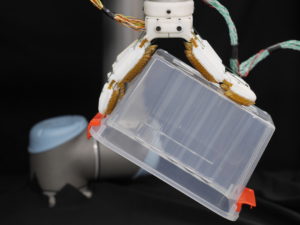Researchers at Stanford University, US, have developed a robotic hand which can grasp with delicate strength, combining adhesives based on gecko toes with a customised robotic hand.
According to the team, while there is a range of robotic hands and clamps available, many struggle to gently hold a tomato or an egg.
“You’ll see robotic hands do a power grasp and a precision grasp and then kind of imply that they can do everything in between,” said Wilson Ruotolo, a former graduate student in the Biomimetics and Dextrous Manipulation Lab at Stanford University. “What we wanted to address is how to create manipulators that are both dexterous and strong at the same time.”

The result is “farmHand”, a robotic hand developed by engineers and detailed in a paper published in Science Robotics. In their testing, the researchers demonstrated that farmHand is capable of handling a wide variety of items, including raw eggs, bunches of grapes, plates, jugs of liquids, basketballs and even an angle grinder.
FarmHand benefits from two kinds of biological inspiration. While the multi-jointed fingers are reminiscent of a human hand, the fingers are topped with gecko-inspired adhesives. This grippy but not sticky material is based on the structure of gecko toes and has been developed over the last decade by the Biomimetics and Dextrous Manipulation Lab.

According to the team, similar to gecko’s toes, the gecko adhesive creates a strong hold via microscopic flaps. When in full contact with a surface, these flaps create a Van der Waals force – a weak intermolecular force that results from subtle differences in the positions of electrons on the outsides of molecules.
As a result, the adhesives can grip strongly but require little actual force to do so. Additionally, they don’t feel sticky to the touch or leave a residue behind.
“The first applications of the gecko adhesives had to do with climbing robots, climbing people or grasping very large, very smooth objects in space. But we’ve always had it in our minds to use them for more down-to-earth applications,” said Professor Mark Cutkosky. “The problem is that it turns out that gecko adhesives are actually very fussy.”

The problems occur due to the need for the adhesives to connect with a surface in a particular way in order to activate the Van der Waals force. This is easy enough when applied smoothly onto a flat surface, but much more difficult when a grasp relies on an object at various angles.
Below the adhesives, farmHand’s finger pads help address this challenge. They are made of a collapsible rib structure that buckles with little force. No matter the location or angle of contact, the ribs consistently buckle to ensure equal forces on the adhesive pads and prevent any single one from slipping prematurely.
“If you move these ribs, the buckling results in a similar force no matter where you start,” said Brouwer. “It’s a simple, physical behaviour that could be deployed even in spaces outside of robotics, perhaps as shoe tread or all-terrain tires.”
Further improvements to farmHand could come in the form of feedback features that would help users understand how it is gripping and how it could grip better while the hand is in use. The researchers are also considering commercial applications for their work.







